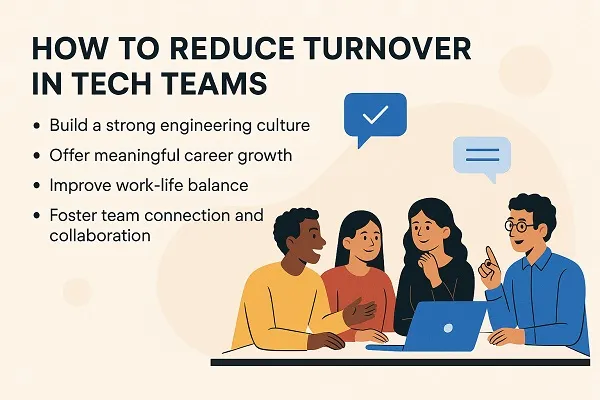Reducing turnover in tech teams is one of the most pressing challenges for engineering leaders and HR professionals alike. The competition for top technical talent is fierce, and retaining skilled developers, data engineers, and product specialists requires more than just good pay. The key lies in building an environment where people feel valued, supported, and motivated to stay long-term.
Build a Strong Engineering Culture
A strong engineering culture is at the core of retaining talent. When developers feel part of a purposeful, collaborative, and supportive culture, they are less likely to seek opportunities elsewhere.
- Encourage open communication: Tech employees appreciate transparency about company goals, product direction, and technical decisions.
- Promote autonomy: Give teams ownership over their projects. Empowering engineers to make decisions helps them stay engaged.
- Recognize achievements: Regular acknowledgment of good work keeps morale high and builds trust.
A culture built on respect, trust, and recognition significantly reduces turnover because employees feel connected to something larger than their job description.
Focus on Management Quality
Leadership has a direct impact on retention. Many talented professionals leave not because of the work itself, but because of poor management.
What Effective Tech Managers Do
- Set clear expectations without micromanaging.
- Offer constructive feedback and regular one-on-one check-ins.
- Remove obstacles that slow down productivity.
- Create a safe space for sharing concerns or ideas.
Managers should also understand the technical aspects of the team’s work. This helps them make better decisions and earn credibility among engineers.
Offer Meaningful Career Growth

High-performing tech professionals are naturally ambitious. If they don’t see growth paths within the company, they’ll look elsewhere.
Ways to Support Career Growth
- Create internal mobility: Allow engineers to explore different technical areas or roles within the organization.
- Provide mentorship: Pair senior engineers with junior or mid-level developers to foster growth and knowledge transfer.
- Define clear advancement frameworks: Transparent promotion criteria give team members a sense of progress and stability.
Career progression isn’t only about titles; it’s about continuous challenge and purpose. When employees see a future, they stay.
Improve Work-Life Balance
Overworking developers is a quick way to burn them out. In the fast-moving tech world, setting healthy boundaries ensures long-term productivity and satisfaction.
- Encourage reasonable workloads and discourage unnecessary overtime.
- Offer flexible work schedules that allow employees to manage personal responsibilities.
- Support remote or hybrid work options when possible.
Tech teams that feel trusted to manage their own time are generally happier, more productive, and less likely to leave.
Strengthen Onboarding and Integration
The first few months define how long someone will stay. A disorganized onboarding process can make even great hires question their decision.
Key Elements of Effective Onboarding
- A clear roadmap of what success looks like in the first 90 days.
- Access to tools, documentation, and mentors from day one.
- Early involvement in meaningful projects to create a sense of contribution.
Smooth onboarding helps new team members feel connected faster, reducing early turnover rates.
Foster Team Connection and Collaboration

Strong relationships within the team increase loyalty and overall satisfaction. A connected team is far less likely to fragment.
- Host team retrospectives that focus on improvement, not blame.
- Encourage cross-functional collaboration between developers, designers, and product managers.
- Use collaboration tools that streamline communication and reduce friction.
Teams that work well together stay together. Building a sense of camaraderie can be one of the simplest yet most effective ways to lower turnover.
Align Compensation with Market Value
While salary isn’t the only reason people stay, it’s a major one. Regularly benchmark compensation packages to ensure your company stays competitive.
- Offer fair base pay aligned with market standards.
- Include performance-based bonuses or profit sharing.
- Provide equity options to create a sense of ownership in the company’s success.
Also, don’t overlook non-monetary benefits like wellness programs, professional development budgets, and generous leave policies. These contribute significantly to overall satisfaction.
Identify and Address Burnout Early
Burnout is one of the biggest drivers of turnover in tech teams. It often develops gradually and can go unnoticed until it’s too late.
Prevent Burnout by:
- Monitoring workloads and project deadlines realistically.
- Encouraging time off after major releases or stressful sprints.
- Training managers to recognize early signs of disengagement or fatigue.
When leaders proactively address burnout, they protect both productivity and retention.
Conduct Regular Stay Interviews

Instead of waiting for exit interviews, conduct stay interviews to learn what motivates employees to remain. These conversations help uncover hidden issues before they lead to resignations.
Questions to ask:
- What keeps you motivated here?
- What frustrates you about your work or environment?
- How can we make your job more rewarding?
By taking action based on this feedback, you show employees that their opinions truly matter.
Measure and Analyze Turnover Patterns
To effectively reduce turnover, you need to understand its root causes. Use data to identify trends and take targeted action.
- Track turnover by team or department to spot problem areas.
- Analyze exit interview data to see recurring themes.
- Compare turnover rates with industry benchmarks to gauge competitiveness.
Data-driven insights can help leaders implement changes that actually work, rather than relying on assumptions.
Creating an environment where engineers feel valued, challenged, and supported is the foundation for reducing turnover in tech teams. When leaders invest in culture, management, compensation, and well-being, they build teams that stay loyal and perform at their best — which in turn drives stronger business outcomes and a healthier organization overall.
Content reviewed and published by Tier2Tek Staffing Editorial Team .

